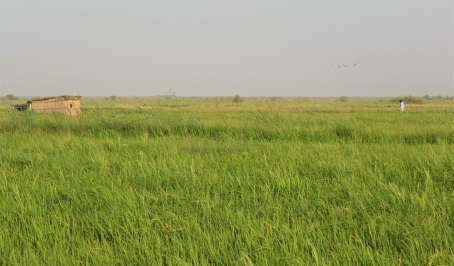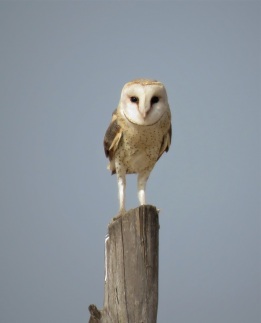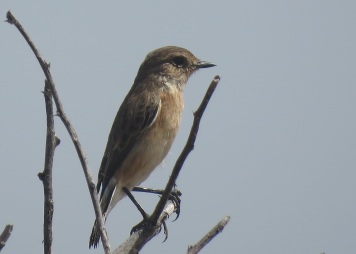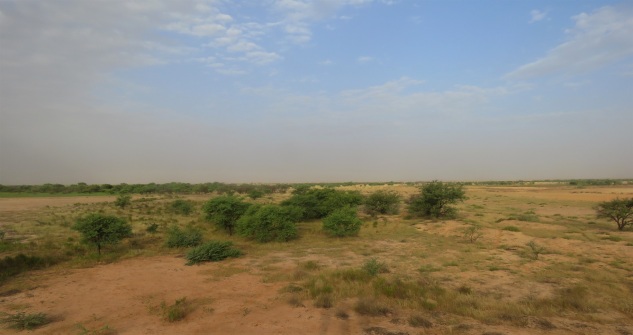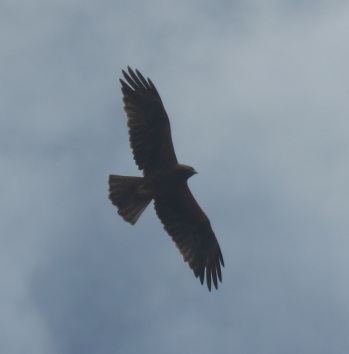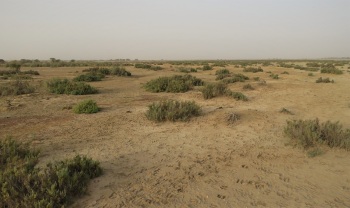Virée dans le delta, en images
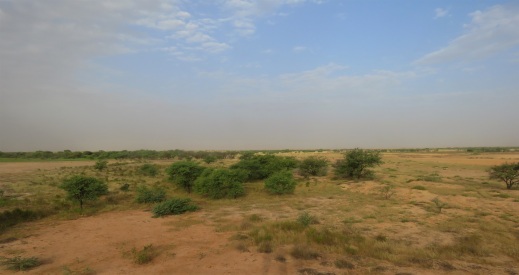
Pas trop le temps pour écrire en ce moment (trop d’oiseaux à compter au Calao!) je voulais tout de même partager quelques clichés pris lors d’une nouvelle visite au Bas-Delta du fleuve Sénégal, au tout début du mois. En compagnie, bien sûr, du référent local et fin connaisseur de l’avifaune de la région – que dis-je, de la faune tout court – Frédéric Bacuez. D’abord les environs de Bango et les Trois-Marigots, puis une journée dans le parc national du Djoudj avec Vieux, Miguel et Rosa en plus dans la bande, puis pour terminer une matinée dans la réserve de faune du Ndiael. Pas loin (voire un peu plus) de 200 espèces observées pendant notre long weekend ornitho, tous les détails comme d’hab sur eBird.
Sans plus tarder, voici donc en ordre chronologique une petite série d’images:
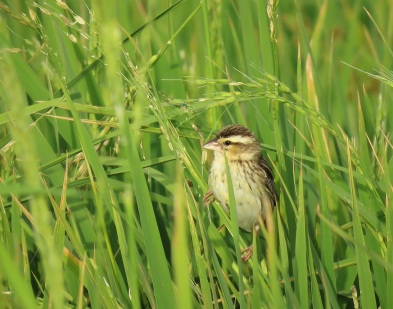
Yellow-crowned Bishop / Euplecte vorabé (juv.?) le 1.11 dans la plaine de crue du fleuve, ici dans une rizière près de Mberaye et son canal de décharge
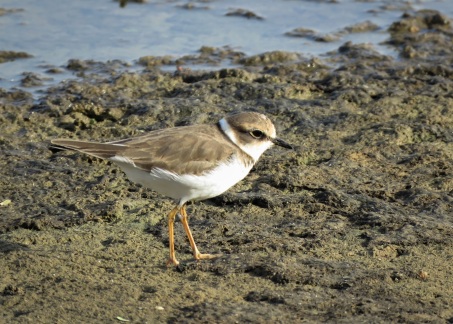
…un Petit Gravelot (Little Ringed Plover) au bord d’une des nombreuses flaques résiduelles après les pluies, certes modestes ici, de ces derniers mois.
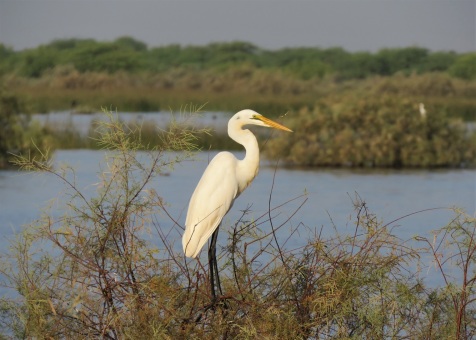
Great Egret / Grande Aigrette, au bord de la “mare” de Ross-Bethio. Encore assez peu d’oiseaux ici mais tout de même déjà quelques canards: Pilet, Souchet, Sarcelle d’été.
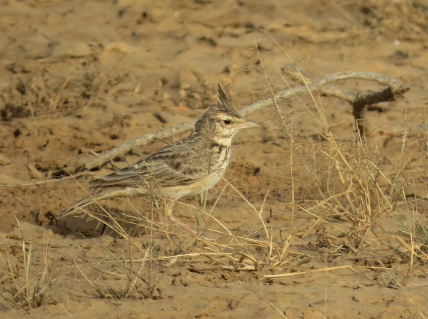
Crested Lark / Cochevis huppé (Djoudj), juste pour rendre hommage à ce sympathique passereau commun dans les zones côtières du pays, mais trop souvent ignoré par les ornithos…
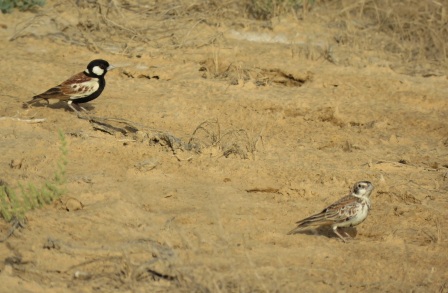
Chestnut-backed Sparrow-Lark / Moinelette à oreillons blancs, un couple près du Grand Lac dans le Djoudj…
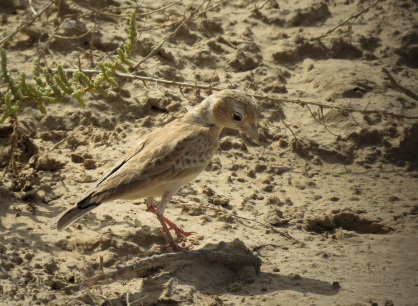
… puis dans la même zone, une femelle de Moinelette à front blanc (Black-headed Sparrow-Lark). Les deux espèces de moinelette, en plein dans la période de reproduction, sont cette année bien présentes dans la région et elles sont souvent facilement observables. Notez le plumage plus uniforme et plus clair que la femelle de l’espèce précédente.
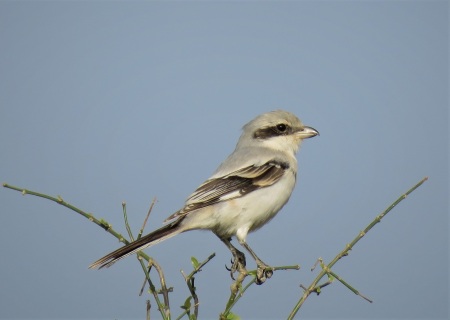
“Desert” Grey Shrike / Pie-grièche “du desert”, nom qui lui convient tout de même mieux, car après avoir été incluse pendant des années dans le groupe de la Pie-grièche méridionale, la rattacher à la Pie-grièche grise d’Europe centrale et du Nord me semble un peu farfelu. Ici très probablement le taxon elegans.
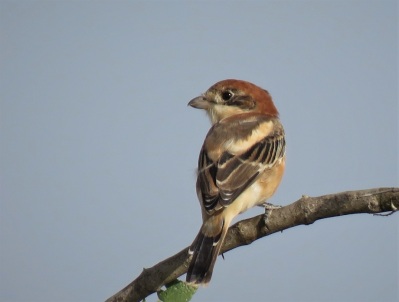
L’autre Lanius du coin, la PGTR (Pie-grieche à tete rousse / Woodchat Shrike), en pleine mue de la queue. Notez également le contraste de mue entre d’un côté les tertiaires et primaires (très sombres au bord blanc bien marqué), et les secondaires brunes bien usées de l’autre.
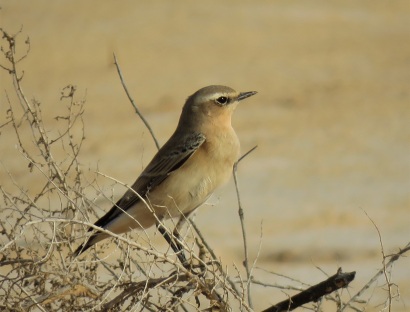
Northern Wheatear / Traquet motteux, dans le Djoudj également. Pas eu la chance de tomber sur un Traquet de Seebohm – plutôt restreint à l’extreme-nord apparemment – ni sur une cousine Isabelle, un neveu du Désert ou un oncle Oreillard…
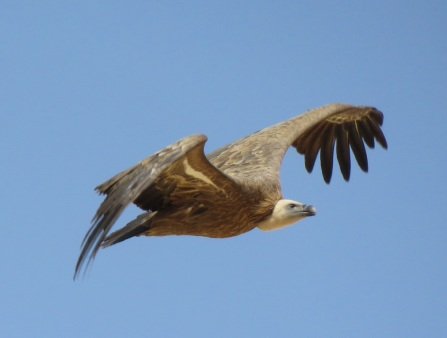
Eurasian Griffon / Vautour fauve imm., l’un des 113 (!) sujets rencontrés près du Grand Lac, d’abord tous au repos par terre et dans les quelques arbres parsemant la plaine, puis en vol lorsque le groupe a décollé avec les premiers thermiques de la matinée. Sans doute ces oiseaux venaient-ils d’y passer la nuit, après la grande traversée du Sahara. Peut-être l’un des plus grands groupes, si ce n’est le plus grand, jamais observé au Sénégal?
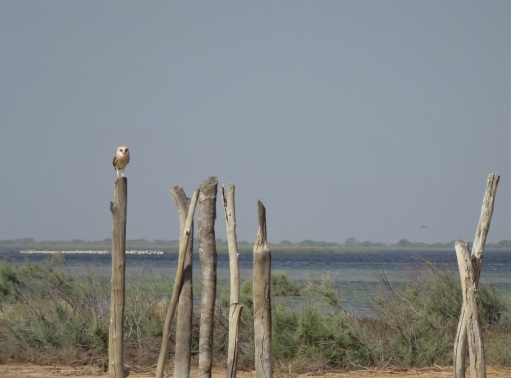
Autre moment fort de la journée, cette Effraie des clochers (Barn Owl) qui niche dans l’un des miradors du Grand Lac, avec pour le moment trois oeufs déposés à même le sol de l’observatoire. Site de nidification pour le moins original!
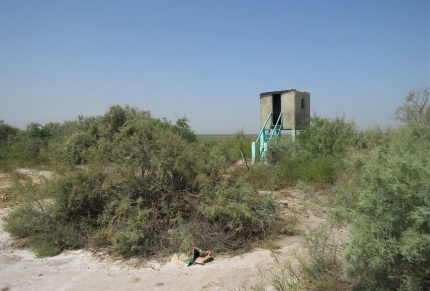
L’observatoire “Tantale”, zone où nous avons de nouveau contacté la Gorgebleue, le Tarier d’Afrique, les Prinias aquatiques évidemment, et bien d’autres passereaux!
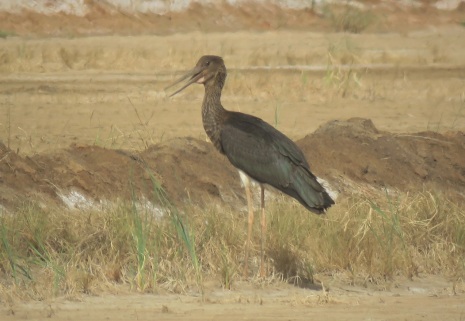
Une jeune Cigogne noire (Black Stork), espèce d’observation quotidienne pendant ce long weekend, ici au repos dans les cultures non loin du Djoudj.
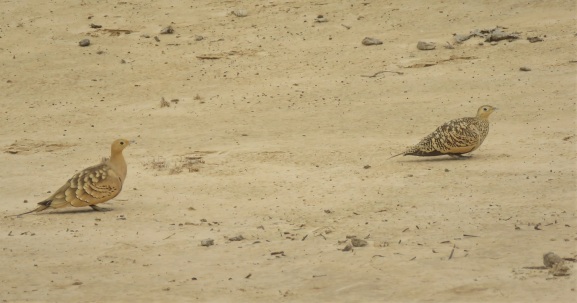
Chestnut-bellied Sandgrouse / Ganga à ventre brun, couple dans la réserve de faune du Ndiael – un site classique pour l’observation de cette espèce toujours aussi agréable à voir!
Iberian Chiffchaff in West Africa
We’re continuing our little series on the status of some lesser known passerines that spend the winter in Senegal. This time round we’re looking at Iberian Chiffchaff (Pouillot ibérique), yet another drab songbird that can be tricky to identify unless of course it’s singing. We won’t go much into its identification in this post; a lot has been written on the topic, though unfortunately the standard West Africa field guides lack sufficient detail and may oversimplify the matter somewhat. In addition, few if any of the local guides really know how to identify the species in the field, and not all visiting birders pay much attention to these LBJs.
There are a few subtle differences in plumage, but generally it’s not easy to identify these birds on plumage and “jizz” alone.. so maybe it’s useful after all to summarise key characteristics here. Lars Svensson, in what is still one of the main reference papers on Iberian Chiffchaff identification (2001), neatly listed the following field characters in comparison with Common Chiffchaff:
- As a rule, the entire upperparts of ibericus are purer moss green than on Common Chiffchaff, lacking the brown tinge on crown and mantle usually present in collybita in freshly moulted plumage in early autumn a very slight brownish tinge can be found on the greenish upperparts of some Iberian Chiffchaffs
- More tinged yellowish-green on sides of head and neck, and has no buff or brown hues at all, or only very little of it behind the eye and on ear-coverts. The breast is whitish with clear yellow streaking
- Typically, has vivid lemon yellow undertail-coverts, contrasting with a rather whitish centre to the belly
- Supercilium on average more pronounced and more vividly yellow, particularly in front of and above the eye
- On average, the legs are a trifle paler brown on Iberian than on Common Chiffchaff, though many are alike
- Bill is very slightly stronger [though I find this one of very little use in the field!]

Iberian Chiffchaf / Pouillot ibérique, Gandiol, 31 March 2016 (BP). Note yellowish supercilium, undertail and flank streaks, dull greenish upperparts, pale brown legs, whitish belly, and apparently also pale bill base
Clearly these are mostly subtle differences and when identifying on plumage alone, a combination of characters should typically be used. Confusion with Willow Warbler is not unlikely, even by experienced birders, and I’m assuming that at least some Iberians are noted as Willow Warbler, especially in mid-winter in northern Senegal when Willow Warbler should in fact be rare, as it winters chiefly in the forest zone further south. The longer wings, pale underparts and paler legs can indeed result in striking similarities between Willow and Iberian. A good pointer to separate these two is that the latter typically dips its tail while feeding, whereas Willow, Warbler characteristically flicks its wings while moving its tail sideways.
The two pictures below were taken by Frédéric Bacuez near Saint-Louis, on 18.4.16 (top) and 20.1.13 (bottom), and while it’s probably impossible to be certain, I do tend to believe these are Iberian Chiffchaffs.
The vocalisations on the other hand are far more reliable and are indeed always ideal in order to confirm an Iberian Chiffchaff, particulary the song. While there’s some variation and there may be some “mixed singers”, the difference with Common Chiffchaff is usually obvious (though maybe a bit less so on this one from Wassadou). It’s worthwhile pointing out though that besides the quite distinctive song, a good yet undervalued criterion is the call of the species – see this nice summary on the Turnstones blog (and also Collinson & Melling 2008, who state that the call “in sharp contrast to that of Common Chiffchaff, is downwardly inflected, from 5 to 3 kHz, transcribed as ‘piu’ or ‘peeoo’, perhaps reminiscent of the call of Siskin” – now compare with my recording from Technopole (same bird as in the song recording): I wouldn’t say this sounds like a Siskin – and even less like a Bullfinch! – and at 3.5-6 kHz the frequency is clearly a bit higher as can be seen on the sonogram below (click to enlarge).
Status & Distribution in Senegal
Up to not so long ago, most authors considered Iberian Chiffchaff to be a resident or partial migrant, mostly due to lack of reliable identification criteria at the time. Svensson (again!) provided the most comprehensive overview of our knowledge of the wintering areas in his 2001 paper, concluding that it is “a long-distance migrant which winters primarily in tropical Africa“. This assumption was however based on very few specimens and even fewer reliable field observations. One of these is of a bird “singing like an Iberian Chiffchaff” by Yves Thonnerieux from northern Ghana, and the only two specimens from wintering grounds are from Mali in 1932 (Segou) and 1955 (Bamako); both were found by Svensson in the museum of natural history in Paris (MNHN). A third specimen was collected in January 1955 in Tunisia, suggesting that some birds may winter north of the Sahara; Svensson also showed that the species is present during spring migration in Morocco (at least late March – early April).
With increased “observer awareness” and better reporting systems, recent years have seen a clear increase in field observations from West Africa, described further below. Combined with the absence of any winter records from the Iberian peninsula, I think it’s quite well established now that indeed most if not all Iberian Chiffchaffs winter south of the Sahara.
To further refine its status in West Africa, we turn to our usual suspects: Morel & Morel provide a single record, presumably obtained by themselves, of a singing bird at Richard Toll on 22-24.2.87 (this is probably the unpublished record “from tropical Africa” that Svensson refers to). This can safely be assumed to be the first published record for Senegal; identification was apparently largely based on song since they write that they compared the song with recordings by Claude Chappuis. It’s quite easy to miss out on this observation though, as ibericus (or brehmi as it used to be known) is only referred to in the annex of Les Oiseaux de Sénégambie (1990), as their sighting was obviously too recent to be included in the near-final manuscript of their book. Of course, the species was at the time still considered to be “just” a subspecies of Common Chiffchaff. Rather curiously, the Morels refer to a significant proportion of Scandinavian Common Chiffchaffs (ssp. abietinus) – up to half! – though we now know that these populations tend to winter in eastern Africa, heading in a south-easterly direction in autumn. Could it be that these were actually Iberian Chiffchaff rather than abietinus?
Moving on, Rodwell and colleagues (1996) refer to three records of calling (singing?) birds in the Djoudj NP in Jan 1990, Jan 1991 and Feb 1992. Sauvage & Rodwell (1998) do not provide any additional records: up to the mid-nineties, ibericus was obviously still considered a rare to scarce winter visitor to northern Senegal. More than a decade later, Borrow & Demey still consider the species’ distribution in Senegal as “inadequately known”, and their map only shows the lower Senegal valley.
As is the case with quite a few other little known taxa that were recently elevated to species rank – think Moltoni’s Warbler, Seebohm’s Wheatear, Atlas Flycatcher – these past few years our knowledge has greatly increased, and it is clear that Iberian Chiffchaff is indeed quite frequent in northern Senegal. Recent reports mainly come from the Djoudj NP – obviously a key wintering site, with decent densities – and from around Richard Toll and Saint-Louis (e.g. Bango, Trois-Marigots, Langue de Barbarie, and see picture above). There are however a number of recent records elsewhere that suggest that the species is more widespread: last winter I was lucky to find a singing bird at Technopole which is thought to be the first record from Dakar; there are also a few reports from the Somone lagoon, though not sure that these are reliable (I have suspected the species here before, but never been able to confirm based on call or song). Rather intriguingly, the species was also seen several times along the Gambia river at Wassadou these past two years: first in December 2017, then more than two months later at least one singing bird that we found on 24.2.18, and again this winter (7.1.19). Finally, another singing bird was reported near Kounkane, Velingara, on 28.1.18 (G. Monchaux) – to our knowledge the first record from Casamance. The observations in these southern locations suggest that the species is more widespread and that it can turn up anywhere in Senegal.
In Mauritania, it appears that up to recently the only records were obtained during extensive field work conducted by the Swiss Ornithological Station, with several birds captured both in spring and in autumn 2003 (Isenmann et al. 2010). There are several more recent reports from around Nouakchott mainly, presumably of birds passing through. In addition to the two aforementioned specimens from Mali, the only other record from that country that I’m aware of is of a singing bird that I recorded in a hotel garden in Bamako, where it was singing for at least a week in January 2016. Burkina Faso should also be part of the regular range, though there again there are just a couple of records, most recently a singing bird reported by van den Bergh from the Bängr-Weeogo park in Ouagadougou in December 2011.
The Xeno-canto range map, which is largely based on BirdLife data, is probably the most accurate when it comes to the winter range (though not for the breeding range, the species being absent from most of central and eastern Spain). It should also include all of northern Senegal, or at a minimum, the lower and middle river valley, particularly the Djoudj NP which is omitted from the map below. I’m not sure that the species has been reliably recorded from Gambia even though there are several unverified observations on eBird. Further north, there are several winter records from Western Sahara between early December and early February, mainly at coastal sites (Bergier et al. 2017), suggesting that not all Iberian Chiffchaffs cross the Sahara. Spring migration is noted from mid-February to mid- or end of April.

Iberian Chiffchaff should be present in Senegal and generally throughout its winter quarters from about October to early or mid-April; the earliest observation I could find is one of a bird reported singing east of Richard Toll on 27.10.15. A Danish group reported two birds in Djoudj in early November 2017, but other than that almost all records are from December – February during the peak orni-tourist season.
Paulo Catry and colleagues (including our friends Miguel and Antonio!) showed marked differential distance migration of sexes in chiffchaffs, with females moving further south than males. Their study did not distinguish between Common and Iberian Chiffchaff, but because south of the Sahara (Djoudj mainly), sex-ratios were more male-biased than predicted by a simple latitude model, their findings suggest that among the chiffchaffs wintering in West Africa, a large proportion is composed of Iberian birds, providing further support that these birds are long distance migrants. The ringing data from Djoudj also showed that chiffchaffs display differential timing of spring migration, with males leaving the winter quarters considerably earlier than females [typically, male migrant songbirds arrive a little earlier on the breeding grounds than females, presumably so they can hold and defend a territory by the time the females arrive].
Finishing off with some essential ibericus reading…
- Collinson & Melling, 2008. Identification of vagrant Iberian Chiffchaffs – Pointers, pitfalls and problem birds. British Birds 101.
- Svensson, L. 2001. The correct name of the Iberian Chiffchaff Phylloscopus ibericus Ticehurst 1937, its identification and new evidence of its winter grounds. Bull. B. O. C. 121.
Le PNOD, le PNLB, la RNICS & la RNP en images
Si vous arrivez à déchiffrer les acronymes du titre, alors chapeau! Faute d’un meilleur intitulé pour ce billet, et faute de temps pour écrire un long article sur tout ce qu’on a pu voir ces huit derniers jours, je vous présente ici quelques images prises lors de notre virée dans le Djoudj (le PNOD – parc national des oiseaux du Djoudj), le PN de la Langue de Barbarie (PNLB), la réserve naturelle d’intérêt communautaire de la Somone (RNCIS), et la réserve de Popenguine (RNP). Huit jours a se ressourcer en pleine nature, en agréable compagnie de nos amis Jan, Maria, Kajsa et Marnix venus découvrir le Sénégal – le bonheur.
PNOD
A commencer par ces Courvites isabelles vus vers le Grand Mirador du PNOD, trouvés par l’excellent guide Vieux Ngom (qui en passant salue toute l’équipe de Genevois!), dans une atmosphère poussiéreuse comme je l’ai rarement vue. Les courvites aussi j’en avais rarement vus, même jamais en fait! Belle coche donc pour commencer les vacances de fin d’année, d’une espèce régulière dans le nord du pays mais qui jusqu’ici m’avait toujours échappée, ici comme ailleurs d’ailleurs.
Voici pour vous faire une idée des conditions météo, qui se résument tout simplement en “vent + froid + sable + poussière”, mais que notre ami d’Ornithondar a très bien expliqué ici. Jamais eu aussi froid au Sénégal… A peine 15 degrés au petit matin… suffisamment peu pour justifier au moins trois couches pour sortir.
Aussi vus dans le Djoudj, dans le désordre: les habituelles Grues couronnées, une ou deux Talèves d’Allen, deux couples d’Anserelles naines, Sarcelles d’hiver, Pie-grièches méridionales, Glaréoles à collier, Tarier d’Afrique, Prinia aquatique, Pygargue vocifère, Fauvette orphée, Alouettes calandrelles, et j’en passe. (Pygmy-Goose, Common Teal, Southern Grey Shrike, Collared Pratincole, African Stonechat, River Prinia, African Fish Eagle, Orphean Warbler, Short-toed Lark). Par contre peu de canards et très mauvaise visibilité sur le Grand Lac, mais Jean-Louis et Maha ont tout de même eu quelques Sarcelles marbrées deux jours plus tard, tout comme l’Outarde arabe et plein d’autres choses (Marbled Teal, Arabian Bustard).
Mais aussi Loup africain, Phacochères à volonté, un Crocodile du Nil, et pas moins de trois Pythons de Seba pour le grand bonheur de tout le monde mais peut-être surtout pour mes amis Jean-Louis et Maha, à peine arrivés au Sénégal.
PNLB
Passons maintenant au PNLB, ou l’on a passe deux nuits dans notre lodge favori au Senegal: le Zebrabar, niche entre lagunes et ocean, un petit havre de paix qui invite à la relaxation et au far niente… si ce n’était pour tous les oiseaux qu’il y a à découvrir! Même le jour de Noël on ne chôme pas, bien au contraire: en fin de matinee je passe d’abord à la STEP de St. Louis qui comme toujours grouille d’oiseaux, dont le Prinia aquatique, la Rousserolle des canes, plusieurs centaines de Dendrocygnes veufs et fauves tout comme quelques Canards souchets, et une bonne diversité de limicoles (River Prinia, Greater Swamp Warbler, White-faced & Fulvous Whistling-Ducks, Northern Shoveler). Mais surtout, je tombe sur une belle surprise sous la forme d’une Marouette de Baillon que je lève en bordure du sentier entre les deux plans d’eau principaux. Et que j’aurai ensuite le plaisir d’observer et de photographier pendant plus d’une demie heure – quel bonheur! Seulement ma deuxième obs de l’espèce, mais bien meilleure que la première, il y a près de 10 ans aux Pays-Bas.
Au retour de la STEP, brève escale au bord de la piste qui mène au Niokobokk: une Pie-grièche mériodionale (ou doit-on dire Pie-grièche du désert maintenant? voir cet article sur Ornithondar). J’essaierai de revenir sur la question des (sous-)espèces en 2018…
En fin d’après-midi, je pars dans la plaine et la brousse derrière Mouit, là où j’avais eu entre autres Outarde de Savile, Coucou-geai, Oedicnème tacheté et cie. lors de mes précédentes visites. Parcourant la steppe à la recherche de fauvettes (le site me semble idéal pour la Fauvette à lunettes notamment) ou autres pipits, je tombe sur ce Hibou des marais – le sixième au moins depuis début novembre au Sénégal, confirmant ainsi le petit (?) afflux qui a visiblement lieu encore en ce moment. Combien passent inaperçus? J’ai donc une fois de plus dû mettre à jour l’article que j’y avais consacré il y a quelques semaines, avec l’image en plus et quelques obs supplémentaires (dont une de la lagune de Somone).
Ci-dessous le biotope:
RNICS
Ensuite, après un crochet par Lompoul (Outarde de Savile, Oedicneme tacheté, Petit Moineau, Guêpier d’Orient et j’en passe; Savile’s Bustard, Spotted Thick-knee, Bush Petronia, Little Green Bee-eater), on pose les valises au Dalaal Diam près de la lagune de Somone.
Là, j’en profite pour retourner dans mon coin à Engoulevents à balanciers: rien vu! Ils ont dû repartir sous d’autres cieux. Curieusement, comme en octobre, une Bondrée (Honey Buzzard) me passe par-dessus la tête en filant vers le sud. Vu le plumage c’était un autre individu qu’en octobre, un jeune individu assez roux. Et à la place des Petits-ducs africains, cette fois ce sont au moins deux Chevêchettes perlées (Pearl-spotted Owlet) qui se font entendre de nuit (et parfois de jour) dans le jardin du lodge. Une Cigogne noire (Black Stork) survole le site, un Busard cendré chasse en bordure de la lagune, des centaines de Moineaux dorés du Soudan se mêlent aux Travailleurs a bec rouge et autres tisserins. Et curieusement toujours, je trouve deux Hypolaïs pâles (Eastern Olivaceous Warbler) non loin de la zone où j’avais déjà observé cette espèce peu connue en Sénégambie, en mars 2016. Hiverneraient-ils dans le secteur? Les deux oiseaux évoluaient ensemble et étaient peut-être en couple, à moins qu’il ne s’agisse de deux mâles se disputant un buisson stratégique… Quoiqu’il en soit, l’identification était relativement simple car les deux oiseaux hochaient activement la queue tout en ouvrant les ailes vers le bas, et la structure (notamment le bec plus fin) et les critères du plumage concordent; le chant semblait aussi assez différent de l’Hypolaïs obscure – je dois encore traiter et analyser les quelques prises de son, qui je l’espère ne seront pas trop affectés par le vent.
RNP
Point de photos de Popenguine à part un jeune Circaète Jean-le-Blanc (Short-toed Eagle) un peu flou, mais à signaler notamment neuf ou dix Hirondelles de rochers (Crag Martin), deux Monticoles bleus (Blue Rock Thrush), quelques discrets Bruants d’Alexander (Gosling’s Bunting), 4-5 Beaumarquets melba, 2-3 Sporopipes quadrillés (Speckle-fronted Weaver). Visite depuis Guéréo, hier matin 29/12. Au retour, on passe par le Lac Rose, ce qui permet d’ajouter le Goéland d’Audouin à la liste.
Voilà pour ce tour d’horizon, pas si rapide finalement.
Prochaine expédition: la moyenne vallée du fleuve, dans une semaine à peine. Avant cela, on va essayer de profiter des quelques jours de congés restants pour passer au Technopole, les steppes du Lac Rose ou encore la lagune de Yene.
Search / Cherchez
Recent Posts / Article récents
Tag Cloud
Adamawa Turtle Dove African Grey Hornbill Allen's Gallinule Alpine Swift American Golden Plover Audouin's gull Baillon's Crake Baird's Sandpiper Bateleur Black-winged Stilt Blue Rock Thrush Bridled Tern Brown Booby Buff-breasted Sandpiper Cap Vert IBA Cinereous Vulture Colour rings Common Shelduck Cream-coloured Courser Crested Lark Delta du Saloum Desert Grey Shrike Djoudj Eastern Olivaceous Warbler Egrets Eurasian Griffon Flamingo Forbes's Plover Fork-tailed Drongo Franklin's Gull Gosling's Bunting Green-winged Pytillia Grey Phalarope Hooded Vulture Horus Swift hybrid Iberian Chiffchaff Identification Isabelline Wheatear Jack Snipe Kordofan Lark Lac Mbaouane Lac Rose Lac Tanma Lagune de Somone Laughing Gull Lesser Jacana Lesser Yellowlegs Little Grey Woodpecker Long-crested Eagle Long-tailed Skua Magnificent Frigatebird Mali Firefinch Meadow Pipit Mediterranean Gull migration Nearctic vagrants Ngor Niayes IBA Northern Wheatear Osprey Pallid Swift Palm-nut Vulture Pel's Fishing Owl Pelagic trip Peregrine Falcon Petite Cote IBA Popenguine Red-billed Tropicbird Red-footed Booby Red-necked Phalarope River Prinia Rufous-tailed Scrub Robin Sabine's Gull Sahel Paradise Whydah Sanderling Seawatching Seebohm's Wheatear Shearwaters Short-eared Owl Short-toed Eagle Shrike Skuas Slender-billed Gull Square-tailed Drongo Standard-winged Nightjar Storm Petrels Technopole Turati's Boubou Vagrants Vultures Whimbrel White-fronted Black Chat Woodchat Shrike Yellow-legged Gull Yellow-throated Longclaw Yellow Wagtail Yene-Tode Zebra WaxbillHeader photos
The defunct, twin volcanoes of Mamelles, in Dakar’s Ouakam arrondissement, with Cape Verde Shearwaters and Bottle-nosed Dolphins. The rocky coast of Dakar, forming the Cap Vert Important Bird Area, is an outstanding site for seabirds (photo: P. Robinson). Technopole and its numerous waders, herons, gulls, terns and other waterbirds (including Greater Flamingos when conditions are right) is one of the best sites for birds in the greater Dakar region, So is Iles de la Madeleine, and further afield the Saloum Delta at Palmarin (photos: B. Piot)
A selection of our pictures / Galérie de photos
Copyright
© The authors and Senegal Wildlife 2012-2020. Unauthorized use and/or duplication without permission from this blog’s authors is prohibited. Excerpts and links may be used, provided that full and clear credit is given to the author(s) and Senegal Wildlife, with appropriate and specific direction to the original content.

